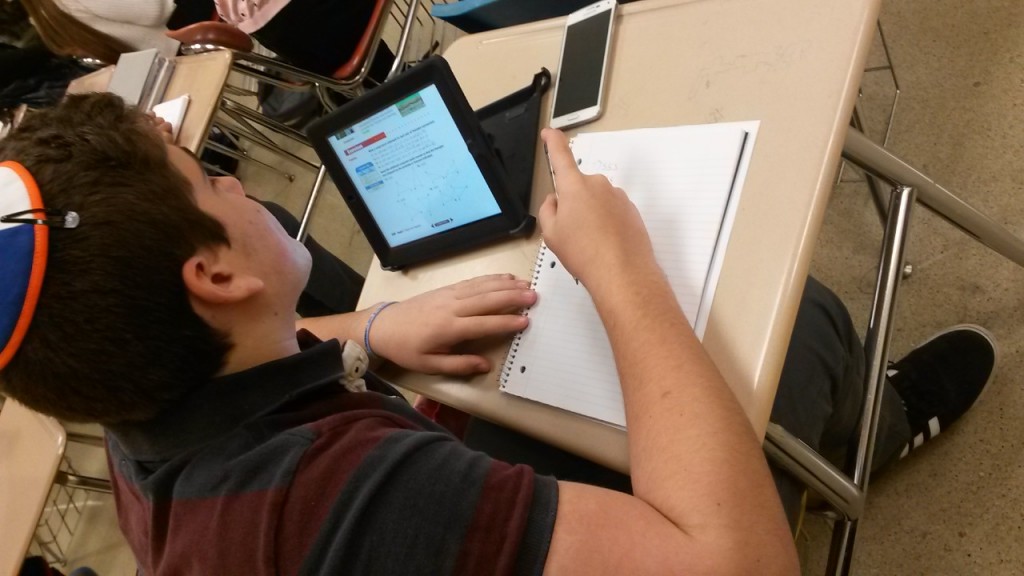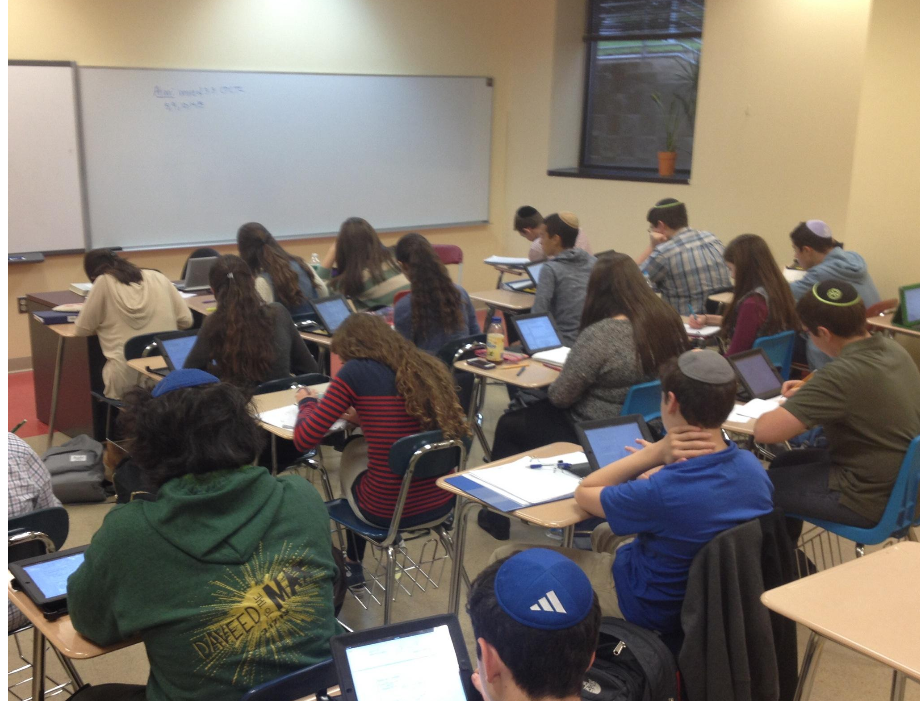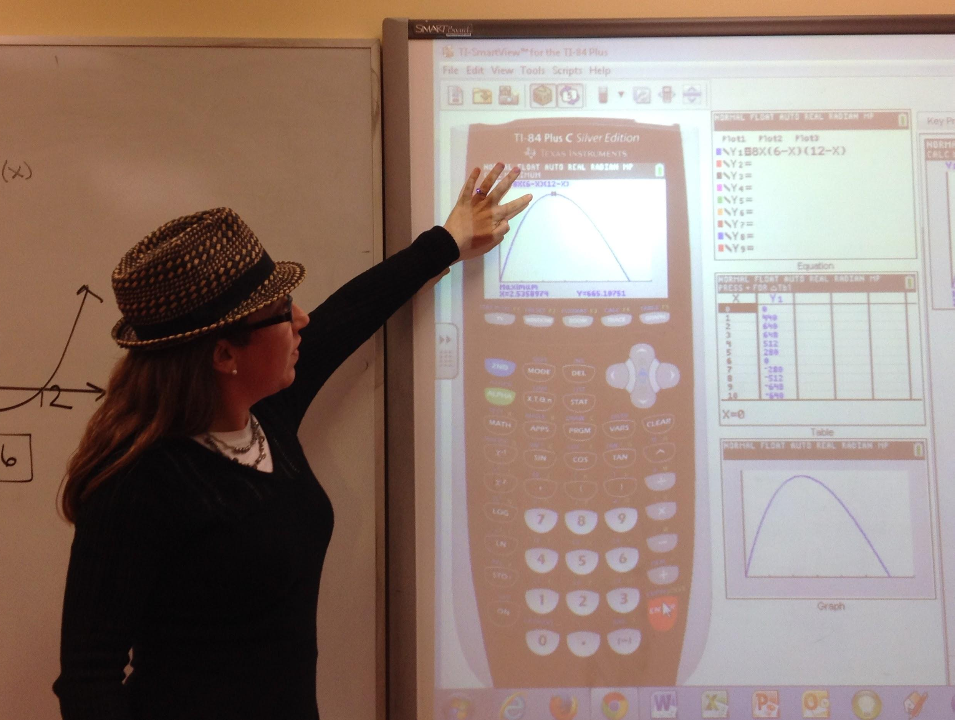It has been a productive and successful year for the Frisch math department. Below is a “Year in Review” of all the math department’s activities from flipped classrooms, blended learning, real time assessment, continued standardized test preparation, and an integration day of Torah and math. Additionally the math department took part in more professional development than ever before. We are proud of all our ventures into these progressive venues of education and are happy to share brief descriptions of each and knowledge gained from them during this past year.
Flipped Classroom Videos: Mrs. Rhona Flaumenhaft paved the way creating various videos she posted on her own
YouTube channel. Students and parents were able to easily access her videos created with
Explain Everything. The videos, created for both instruction and test review purposes, have been particularly helpful for various students. For instance, those who find the typical speed of classroom instruction possibly too fast for various reasons can now could stop, review, and play again. This is especially helpful for those students who are auditory learners.
Additionally, Mrs. Shira Teichman and Mrs. Chanie Schlessinger have also started to explore Flipped Classrooms in the spirit of “virtual snow days”. “Virtual Snow Days” became a hot topic in the press and media this past year as schools attempted to continue student learning even when the building was closed. The math teachers at Frisch feel likewise that every day is a chance to learn. So, by the fourth frustrating snow day, Shira and Chanie each created a video in place of their usual frontal classroom instruction. Then when students returned to the classroom, they worked on problems corresponding to the topics in the videos. Since there was less time spent on introducing the topic, students appreciated having more classroom time to work on the algebraic skills whether as a group and individually.
A third benefit of flipping the classroom is that by outsourcing the basics to the video, students can spend additional class time conquering harder, higher-order thinking math problems in class while the teacher is present to guide and assist the students. Both teachers were grateful to not lose yet another day of teaching. There are plans to create additional videos on the topic of
direct and indirect variation this summer in preparation for what could be another harsh winter.
Blended Learning: The Frisch math department received a generous grant through the
Digital Jewish Learning Network to start a blended learning component for several of the math tracks at Frisch. The overall goal of the program is to have students gain more mastery and then better retention through differentiated review and assessment. Through customized problem sets students will be working on prior fundamental skills or current classroom topic dependent on their math track. Though the program will not be fully launched until September 2014, Mrs.
Sabrina Bernath and Mrs. Elissa Katz were able to pilot the program this year with 40 students. Using a free three month trial of
Catchup Math, Sabrina and Elissa, implemented a blended learning component into their 10th grade Algebra 1. Using Catchup Math, students were either assigned homework from the program rather than the textbook or did test review work in custom made problem sets. Besides greater student accountability, there was more more time spent on instruction and less time spent on administrative tasks like collecting and returning homework since all of the classes work was all accounted for on the program’s teacher dashboard. Catchup Math also gave students instant feedback on whether their answers were correct rather than waiting to check-in the back of the book or until the teacher looked over the work.
The benefits of this new initiative were evident within the first few weeks of our pilot. Quiet students were given a chance to shine. For example, one girl in particular was always very quiet in class simply shaking her head when called on by the teacher, but through Catchup Math the teacher was easily able to see her effort by getting readouts of her time spent on task and the number of problems she completed successfully. Not only did she do the assigned problem sets but she did all 9 of them entirely in one night. While her work was not perfect, it showed the teacher she had not only a strong grasp on the material but also that she put forth tremendous effort to succeed.
Other students felt the break from learning from a textbook was refreshing and made the homework actually more fun. Although the initial pilot has only provided us with anecdotal evidence thus far, the test scores on the material supplemented with Catchup Math appeared to be higher than the grades of students from past years on the same material. Additionally, student errors on the exam were more careless than conceptual in nature which seems to show a greater understanding of the concepts than past students have demonstrated.
Real-time assessment:
This year several of the Algebra 1 and Algebra 2 courses benefited regularly from real time assessment provided by a program called
Problem-Attic. Whether as “ Do Nows”, exit slips, or structured group work, students used their phones or iPads to enter their answers to various multiple choice or fill in the blank questions on a worksheet after scanning in the paper’s QR code. Once the code was scanned and answers were submitted, both the teachers and students were emailed the students’ scores. Additionally on the teacher dashboard which could be displayed on the Smartboard, the teachers and students were able to see breakdowns of what percentage of the class understood each individual question and what were the percentages of students who chose A, B or C for the multiple choice questions. When 80% of the class picked the same wrong answer for a simple question, the teacher got immediate feedback what skills had to be add to the day’s lesson.
The speed and level of detail of this real-time assessment was invaluable. For instance when teaching a lesson on percentages, Mrs. Bernath was quickly able to decipher which topics the majority of the class already showed mastery of and more importantly which ones the students did not seem to know. Rather than starting her lesson with more percentage word problems which the class was not yet ready for, she was able to step back and review the idea of solving simple percent problems such as 80% of 30 is what number. This type of lesson quickly became an exciting and popular choice with the students. They were able to articulate that they felt in more control of the lesson both in terms of its pace and content.
Standardized Test Preparation: Tenth graders in our Algebra 1 class help pilot an SAT/ACT prep initiative. After each exam, students were given 4 to 5 SAT questions which corresponded to the material they were just assessed on. This supplemental program is being expanded for all tenth grade math classes next year with the goal of including more classes in the coming years. The worksheets are also being put into a Google Doc where students can access the questions remotely.
Integration Days: Rabbi Gedaliah Jaffe, a teacher in the Frisch Talmud and Chumash Department gave the honors 9th grade Geometry classes a wonderful talk about the mathematics involved in determining an eruv. Students got to see the direct application of math topics such as area of a circle and right triangle trigonometry as the Gemera discussed the concept of Tchum Shabbos. To see the direct use of mathematics in halachic discussion was fascinating and particularly relevant as the students had just finished studying those very topics.
Here are some student reflections on this Torah and Geometry integration.
Professional Development: As lifelong learners whether it is in the areas of math or teaching, the Frisch math department looked for and enjoyed various professional development venues. Teq came for a full day seminar and showed us first hand the educational value of project based learning utilizing iPads to video student created “catapults” and analyze the dataset. In April, five math teachers went to Rutgers University’s
28th Annual Precalculus Conference. They took various classes on teaching methods, technology, AP calc, and Core Curriculum standards. The highlight of the day was an entertaining and stimulating talk by mathematician, professor and author , Dr. William Dunham, Professor of Mathematics at Princeton University on the various ways to prove Heron’s theorem for the area of a triangle. All the math teachers agreed that they thoroughly enjoyed being the students for a day. You can read more about this conference
here.
Additionally we have taken advantage of several professional development opportunities through the
Digital Jewish Learning Network, an off-shoot of
Jewish Education Project. Our department chair, Mrs. Sabrina Bernath attended a panel discussion on blended learning called “ Moving Beyond the Pilot” which was informative and especially timely as we move ahead on our blended learning initiative funded by DJN described earlier in this posting. You can read her reflections
here.
Additionally, just a few weeks ago, two of our Math teachers, Mrs. Chanie Shlesinger and Mrs. Rhona Flaumenhaft attended a conference sponsored by the
Lookstein Center on Flipping the Jewish Classroom together with four Judaic Studies teachers and administrators from Frisch. Although the focus was on the Flipping the Classroom in Judaic Studies, both Chanie and Rhona felt they gained much valuable information and had many thoughtful discussions that they can apply to their Flipped Classroom model in math. You can read Rhona’s reflections on this valuable just in time professional development day
here.
Finally, this post is being written while Mrs. Bernath and Rabbi
Tzvi Pittinsky, Director of Educational Technology, are on a flight to the ISTE conference in Atlanta , Georgia. ISTE is the largest educational technology conference in the world with some 15,000 attendees. Stay tuned for further posts about this conference and how the cutting edge technologies featured at it will be utilized to further improve student engagement and learning in math classrooms at Frisch.
It is an exciting time to be learning and exploring math for both the teachers and students at Frisch. We are grateful for the summer break to have the time to reflect on this past year and to start planning for what will sure to be an exciting new school year in the 2014- 2015 school year.








